Organic tampon subscriptions Lola and Cora are crazy-popular—which one is best?
The rundown on two menstrual brands you've seen on Instagram, and if they're worth it.
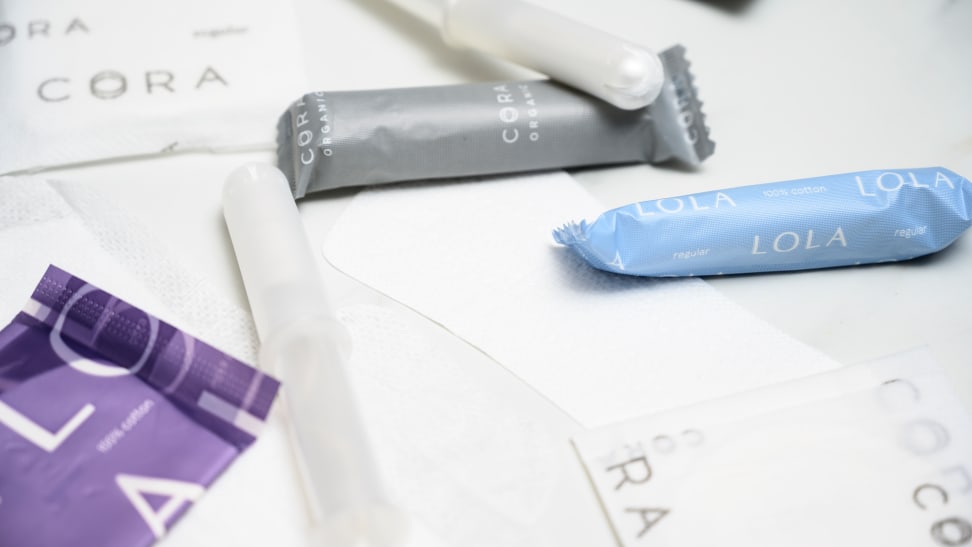 Credit:
Reviewed / Betsey Goldwasser
Credit:
Reviewed / Betsey Goldwasser
Products are chosen independently by our editors. Purchases made through our links may earn us a commission.
We at Reviewed are just as curious about those flashy products we see in our Instagram feeds as you are. For our 'As Seen On IG' series, our writers put them through their paces to find out if they're actually as good as they look online—or too good to be true. Spot one that we've missed? Email us at [email protected].
Today, periods are a big business. Once there were a handful of recognizable menstrual brands—Kotex, Playtex, Always, and Tampax—clustered together in a back aisle at the drugstore and advertised on TV with that inscrutable blue liquid meant to represent menstrual fluid. Now, people with periods have a wealth of items to choose from that extend beyond pads and tampons, such as absorbent period underwear and menstrual cups.
Also on the table? Even more tampons and pads to choose from; namely, organic ones that can be delivered to your door via a subscription service. These have entered the mainstream, thanks to the internet—they are omnipresent on Instagram, Facebook and podcast ads—so if you are a person with a period, it is impossible to scroll through your feed or listen to “My Favorite Murder” without wondering if your period might be improved by chucking that box of drugstore standbys and going organic instead.
To find out, I plucked two popular subscription-based, organic menstrual product brands, Lola and Cora, straight from my Instagram feed and tested them for a few months.
Should your tampons be organic?
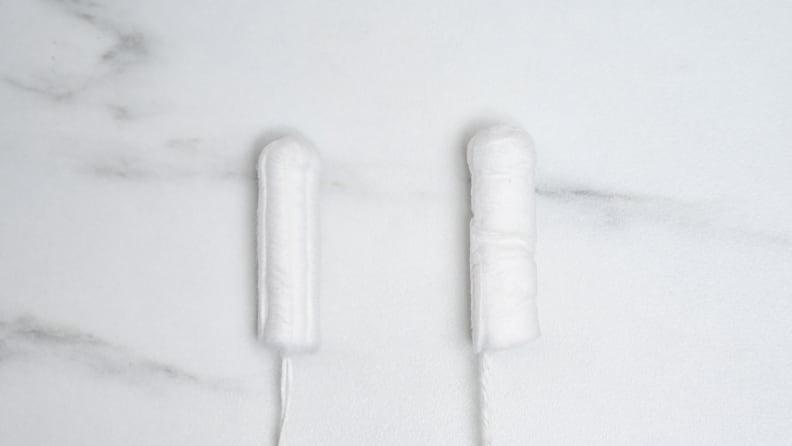
Organic or not, a tampon is a tampon.
On its “about” page, Lola’s website warns that other brands aren’t required to disclose what’s in their tampons (though they do) and could contain toxins, dyes, or synthetic fibers, but the Lola versions are made with just one thing: 100 percent organic cotton. Cora’s site takes a similar approach, touting its organic, pesticide-free cotton sourced from Europe—as opposed to conventional cotton, which Cora claims is farmed with synthetic pesticides. Both brands are certified organic by the Global Organic Textile Standard, an organization that stipulates that its certified products must be made with a minimum of 95 percent organic fibers and cannot contain heavy metals, formaldehyde, aromatic solvents, “functional nano particles,” genetically modified organisms, chlorine bleach, and more. There are also a number of regulations on certified companies' waste management and raw material sourcing that aren't required with conventional textile manufacturers.
To me, a tampon made with pesticide-free cotton sounds like a better option than a dyed, toxin-filled one! But that is also the companies' branding—not to mention minor scare tactics—and it shares the goal that all product manufacturers have, which is to get people to buy their stuff. Not to mention, the cost to upgrade to organic isn’t negligible. Do you have to?
The first issue (which isn’t the fault of these tampon makers, though they take advantage of it): The term “organic” connotes “healthier for you,” when what it really means is “healthier for the earth.” The two things aren’t necessarily independent, but “organic” refers to the sustainability of the farming practices surrounding how the cotton is grown and turned from plant into textile.
To find out about the human health implications, I reached out to an impartial expert with a few questions that basically boiled down to this: Are organic tampons healthier for vaginas than their conventional counterparts?
“Unfortunately, the answer is not that straightforward,” says Dr. Adeeti Gupta, founder of Walk In Gyn Care in New York City. Most conventional tampons are made with a blend of rayon, cotton, and polyester, which may have been bleached with chlorine before being manufactured. Some also contain fragrances and odor neutralizers. “There is a thought but no clear evidence that the bleaching with chlorine may cause the release of a toxin called dioxin, which if absorbed into the bloodstream may cause cellular damage,” Gupta says. “But it's a theoretical risk, which does not mean that we should stop using traditional tampons completely.”
Gupta recommends avoiding scented tampons, which can interfere with your vagina’s pH and natural self-cleaning abilities, according to the Cleveland Clinic. Other than that, all you must do is take the “usual precautions” of normal tampon use, like only using tampons that are in fully sealed packaging and not leaving one in for longer than four hours. Regular changing is important to reduce the risk of Toxic Shock Syndrome (TSS), a rare illness caused by an overgrowth of bacteria. “TSS happens due to a forgotten foreign body in the vagina,” Gupta says. “It doesn't matter if it is organic or not.” (To be fair, this is not a claim that any organic tampon brand seems to make, but based on the other health claims they do make, it wouldn’t be that surprising if someone thought they did.) “Retained tampons are the most common cause of unrelenting vaginal infections,” she says. “And once the infections kick in, it is very hard to turn the pH back to its healthy state.”
In short, you’ll serve your vagina more by practicing good menstrual hygiene and awareness than you will by switching to an organic tampon brand. That said, if you want to switch to organic tampons, there’s no harm in it—other than the bigger dent it may make on your wallet. Just read the ingredients and make sure the brand you pick is certified as organic to ensure you’re actually getting the all-natural promise you’re paying a premium for. You also want to be sure they actually work—which is what I’m here for.
What is it like to order from Lola?
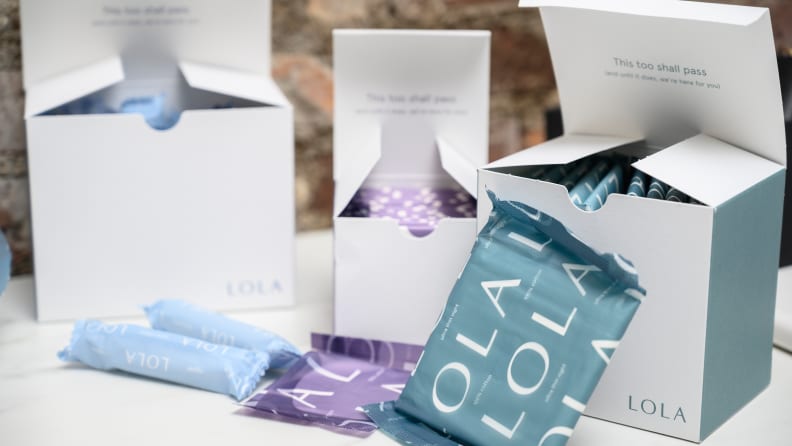
You can take a quiz on Lola's site to find your ideal mix of period products.
When you visit Lola’s site, it directs you to a quiz to find your “perfect” mix of Lola products, which asks you things like what kinds of period products you usually use, how long and heavy your period is, and how often it comes.
I thought the quiz would be a way to push some of the brand’s combo packs—like the “Period Essentials” kit, which contains tampons, liners, and cleansing wipes—but when I finished, I was pleased that Lola didn’t try to oversell to me. It recommended just two items, to be shipped every eight weeks: a box of 18 tampons for $10 (with a plastic applicator, though you can also get a box with cardboard or no applicators—though if helping the environment is your primary goal for switching to organic tampons, you should go for one of these options rather than the plastic ones) and a box of 12 pads for $9. I added both to my cart, plus a box of 28 liners for $9. This, combined with a first-time 15 percent purchase discount of $4.20 brought my total to $23.80. (Shipping is always included.) Before the discount, this translates to a cost of 55 cents per tampon, 75 cents per pad, and 32 cents per liner. If you prefer to skip the quiz, the site offers the option to just shop for what you want.
Something else I liked about the ordering process is that Lola allows you to “edit” the mix of items in your boxes—a tangible benefit that conventional brands don’t offer. Lola suggested I get a mix of super, regular, and light tampons and regular and overnight pads, but it allowed me to change up the quantity of each one to create a combination that worked for me. Basically, the number of tampons and pads you get in a box is always the same, but the kind of tampons and pads that make up the total is up to you.
What is it like to order from Cora?

Cora tampons come in a sleek black box.
Cora’s ordering experience is similar to Lola’s. You take a quiz that asks you similar questions about your flow, usual period experience, and the kinds of products you like using.
Cora ships on a three-month cycle, so it recommended a box of 18 regular tampons (with a plastic applicator, though you can also get an applicator-free version) and 18 pads for a total of $32. I also added on a box of 18 liners for $6 to compare to Lola’s, which brought my total to $38 (like Lola, shipping was included). With your first order, you get a sleek black storage box for your bathroom (or wherever you keep your period products) and a zippered “vegan leather” carrying case that can hold several tampons and pads on the go. I didn’t get a discount when I ordered, but the brand now offers a “starter kit,” which includes a month’s worth of period supplies for $5. Finally, a portion of every Cora purchase goes to charities in the United States and abroad that provide women with menstrual supplies and education. Doing the math on my order, the average price per tampon and per pad netted to 88 cents each, and a liner to 33 cents each.
Some customization is possible with Cora orders but it’s not as precise as Lola’s, which lets you pick and choose down to each item. With Cora, you can pick from a range of pre-set varieties, like half regular and half super tampons and half regular and half overnight pads, all regular and some overnight, or some light and mostly regular. (The more products you get per month, the more customization you have.)
What is it like to use Lola and Cora tampons?
Short answer: They work! Both tampons have compact applicators, which means they are in a small, two-part plastic tube that you extend to insert. I don’t have too much to say about the experience, because the tampons from both brands worked exactly the way other similar tampons work: They were easy to insert, felt comfortable, and did not fall out or cause leaks. On heavier days, I supplemented with liners, but I really didn’t need them.
What is it like to use Lola and Cora pads?
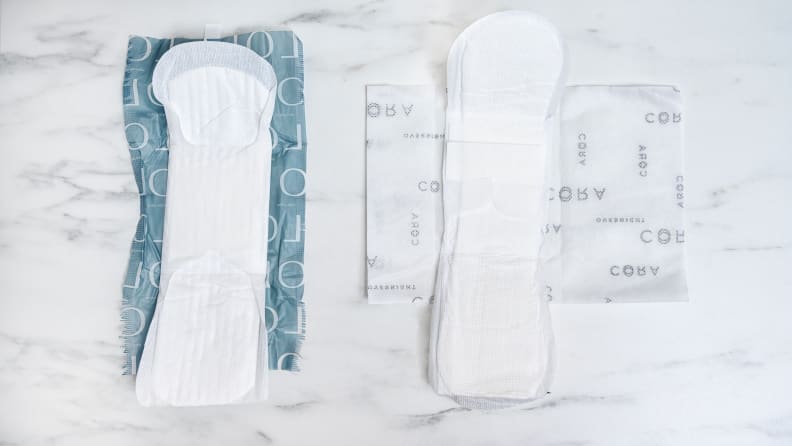
The pads didn't perform as well as we'd hoped.
Short answer: They're not awesome. I will be up front and say I don’t like pads much to begin with—I tested period panties, so I feel like I can get a similar experience in a more eco-friendly way—but I went into testing them with an open mind. My main comparisons? Always Ultra-Thin pads (about as good as pads get, in my opinion) and the brandless, diaper-like maxi pads I’d get from the nurse’s office in middle and high school if I unexpectedly got my period (objectively, about as bad as pads get).
I hit a new low bar, however, when I unwrapped my first Cora pad—a regular “daytime” one—and found that, for some reason, the parts where it had been folded into the wrapper had somehow ripped apart from one another, leaving me with three separate and unusable pad parts. This didn’t happen with any other pad from the box, but even the ones that were functional had issues. They didn’t seem to stick well to my underwear, and the cotton material, though soft, didn’t seem as absorbent as other pads I’ve used before, which meant I felt damp and soggy throughout the few hours I wore them.
Lola’s pads were better, but not by much. The adhesive had sufficient sticking power, but the cotton was stiff, which meant it crumpled up when I moved, and proved messy when I wore one to bed one night and experienced a slight leak. This can happen with any pad (especially when you wear it to sleep), but this seemed to be due specifically to its rigid construction, and it’s not something you want to happen when you wear a pad. (Since my testing, Lola has redesigned its pads, which I have not yet tried.)
Are Lola or Cora subscriptions worth it?
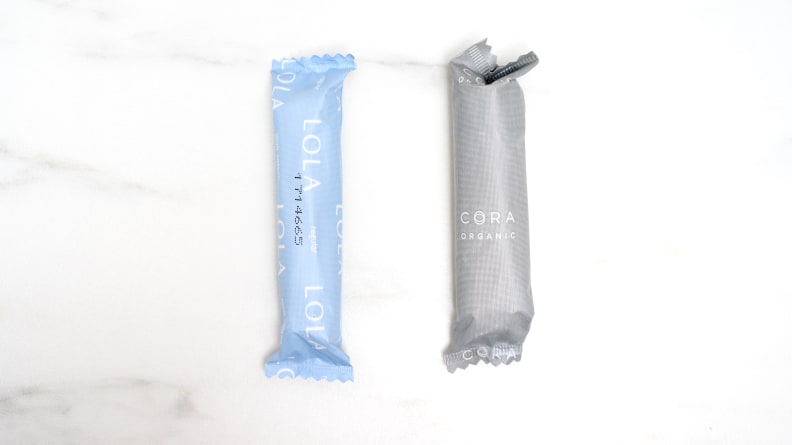
Is there a tangible difference between Lola and Cora tampons?
From a purely financial perspective, no. Using tampons by way of example: A box of 18 conventional Tampax Pearls goes for $3.99 at Target, or 22 cents each. And (surprise!) you can get a box of 18 Cora tampons at the same retailer for $5.99, or 33 cents each. Shop Amazon using its Subscribe and Save service, and you can have any number of brands of conventional or organic cotton tampons automatically delivered at whatever monthly cadence you like for as little as 13 cents each, including (surprise, take 2!) Cora tampons, at about 34 cents each. As a reminder: Cora charges more than double that if you order directly from its site, and Lola's tampons ring in at about 55 cents apiece. Considering how many tampons may be used per period (probably from 10 to 20, but definitely not 7) and the number of periods per year (12, give or take), switching to either is not an insignificant expense.
But if it's the lifestyle you're buying into, or the desire to support a startup with a purpose, you may not mind the markup. In that case, with my experience with the two brands' tampons about even, I’d go with Lola’s service over Cora’s. The ordering process is simpler, the cost is lower, and the option to customize what comes in the shipments is more important to me than a cool carrying case. That said, there's no harm in trying the new $5 Cora starter pack, as long as you remember to cancel before you're charged for the ongoing subscription (unless, of course, you decide to go with it).
If you favor pads, I suggest you keep with conventional brands, or make the transition to period panties if you’re interested in a more eco-friendly approach. Flat-out, I would prefer an Always—or even one of those pillowy, nurse’s office maxi pads—over either Lola or Cora’s offerings. Lola’s pads outperformed Cora’s (at least, none of them fell apart when I unwrapped them), but leakage, crumpling, and lack of sufficient adhesive were present in both brands. I doubt this will be the case forever—both brands make great tampons, so I have to assume they’ll figure out how to make a decent pad at some point—but for now, neither of them are worth forgoing whatever brand you use now.
Bottom line? If you’re interested in stocking your menstrual supply cabinet with organic cotton, don’t want to deal with going to a drugstore every month, and favor tampons over pads, trying some Lola or Cora tampons is a great place to start.


